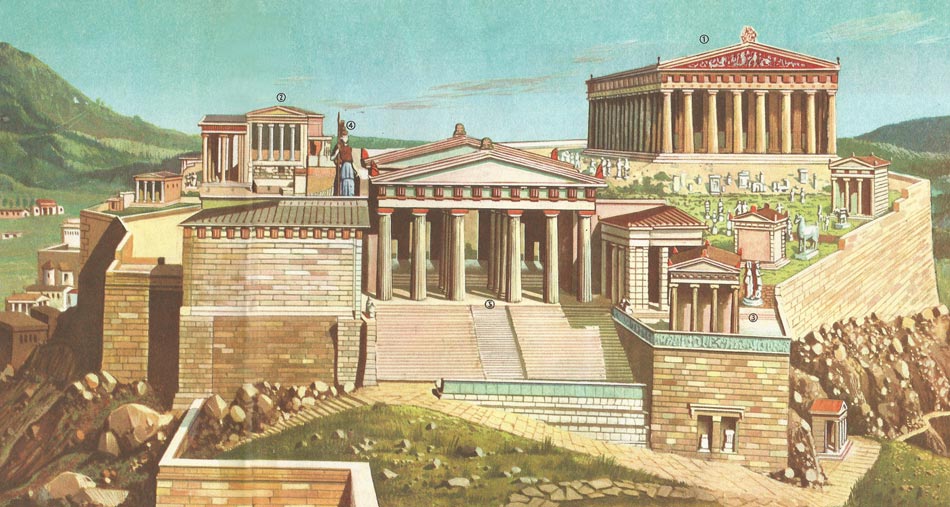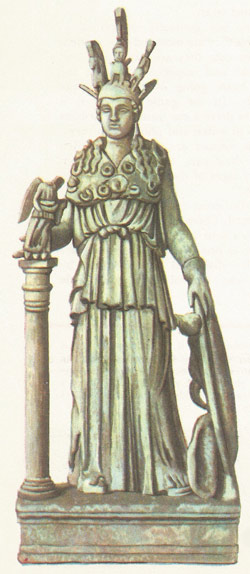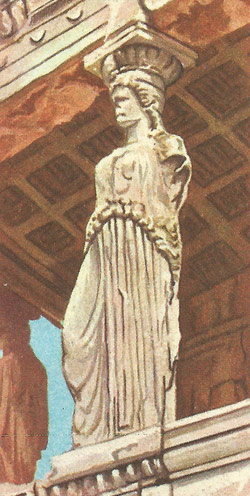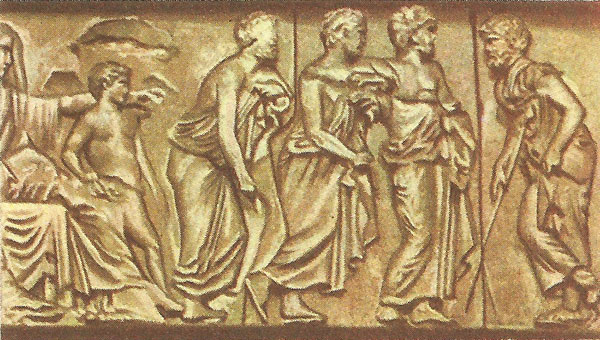The Acropolis

Figure 1. A reconstruction of the principal buildings on the Athenian. Acropolis: 1 the Parthenon, 2 the Erechtheum, 3 the tiny Temple of Athena Nike, 4 the statue of Athena Promachos, and 5 the Propylaea

Figure 2. One of the pediments of the Parthenon, decorated with sculptures designed by Pheidias.

Figure 3. Marble copy of Pheidias' famous statue of Athena, which was in the Parthenon.

Figure 4. The Erechtheum: a karyatid.

Figure 5. Athenian magistrates (part of the Parthenon frieze). Note the fine carvings of arms and legs.
The Acropolis is the acropolis, or citadel, of ancient Athens. Rising high above the city, the fortified outcrop contained the national treasury and many sacred sites and shrines, most of them (such as the Parthenon and the Erectheum) associated with the worship of Athena, the patron goddess of Athens (Figure 1). The present ruins date mainly from the second half of the 5th century BC.
Toward the end of the 5th century BC Athens was among the most beautiful cities in the world. Founded in the middle of the Bronze Age (traditionally by Cecrops), it was named after the city's patron goddess Athena (called 'Athene' in Homer). Athens was not at first very wealthy or important, but it gradually grew so with the development of trade. The first fine buildings were erected toward the end of the sixth century BC, under the rule of Peisistratus and his sons.
Disaster struck when the Persians captured and burnt Athens in 548 BC. But when the Persians had been driven out, the Athenians, led by Pericles, decided to rebuild the ruined temples and other public buildings on the Acropolis (citadel) with as much splendor as they possibly could. With the help of great architects and sculptors, they soon made Athens the envy of Greece and the wonder of the world.
Doric and Ionic
Two styles of architecture were were employed: Doric and Ionic. Ionic columns are more slender than Doric, crowned with 'ram's horns', and have a base. The fluting is also slightly different.
Pentelic marble
The buildings on the Acropolis were constructed of Pentelic marble. This is not dazzling white in color (although it is possible that this marble was a little whiter in ancient times than it is today). It has a slightly golden tinge which is particularly beautiful when seen against the bright blue of the clear Mediterranean sky, and the deep blue of the sea which is clearly visible from the Acropolis.
1 The Parthenon
The most impressive building on the Acropolis is the Parthenon, a magnificent temple dedicated to Athena, the protectress of the city. Designed by Ictinus and Callicrates, it took nine years to build (from 447 to 438 BC), and it was another six years before all the decoration was completed.
The Parthenon is very large, measuring 237 feet long and 110 feet wide, if one includes the bottom step. It is built in a plain Doric style of great simplicity and beauty. Even today it dominates Athens.
At first sight the Parthenon appears to be composed of straight lines and right-angles. In fact, this is an optical illusion: there is hardly a straight line of length in the whole building. The columns lean inwards slightly (about 2½ inches), and in any case are not perfectly cylindrical. The top step is not level either: it is a little higher in the center than at the sides. These slight adjustments were made deliberately, so that the building should appear to the eye to be rectangular. (If they were rectangular, it would not in fact appear so.)
The Parthenon is so called because it contained the famous and colossal statue of Athena Parthenos – 'Athena the Virgin Goddess'. This statue of ivory and gold was the work of Pheidias, the greatest sculptor if the age.
Pheidias was also responsible for designing the marble sculptures that decorate the pediments (the triangular parts) at each end of the Parthenon and the marble frieze round the inner wall and columns. This frieze shows in low relief the religious procession at the great Panathenaic Festival. The carving is most delicately done: the folds of a robe, or the tendons of a horse, are beautifully shown in quite small detail. Much of it was saved from destruction by Lord Elgin early in the nineteenth century, and is now in the British Museum.
2 The Erechtheum
Another famous building on the Acropolis at Athens is the Erechtheum. Besides containing a sanctuary of Athena, it was also the temple of Erechtheus, a mythical king of Athens. This graceful building in Ionic style was erected on one of the oldest religious sites in Athens: hence its strange shape. Outside grows an olive tree, said to have been a gift of Athena.
An interesting feature of this temple is its southern portico, or porch, which is supported by six statues of women, called karyatids (Figure 4), instead of columns.
3 The Temple of Athena Nike
This charming little temple to 'Athena, Goddess of Victory' was designed by Callicrates and was built in 427–424 BC. It is in a simple Ionic style.
4 The statue of Athena Promachos
Near the Propylaea there was another colossal statue, of 'Athena the Defender'. This statue, some 30 feet high, was made of bronze in 460–450 BC, and was also the work of the great sculptor Pheidias. Sailors, miles away in the Saronic Gulf, could see Athena's helmet and spear flashing in the sunlight.
5 The Propylaea
The Athenians wanted to give the Acropolis an entrance worthy of its fine buildings. They therefore built a monumental roofed gateway (propylaea) of Doric columns in Pentelic marble, with inner Ionic columns. Designed by Mnesicles, it was started in 437 BC. But by the time the Pelonnesian War started in 431 BC it was still incomplete and never was finished.
The steep path leading up to the Propylaea was sloping, so that wheeled vehicles in religious processions could come up. In later times steps were cut (as shown in the illustration).
